In this post, originally from November 2007, I used pictures of Gap dresses to illustrate length proportion balancing. I am no longer affiliated with Gap, but somehow the pictures are still here.
Pleasing proportions follow the Fibonacci progression: 1:2, 2:3, 3:5, and so on. Mathematically, they approximate 60/40.
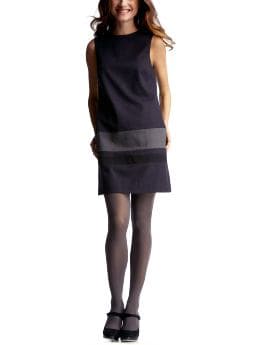
This first one is a little complicated (there are often multiple ways to look at a problem). I suggest that the dress + shoes = 5 (the reason I think mid-thigh dresses are hard to wear is because by themselves they are 4 head-lengths). In this case, I am not figuring the head into the equation. The legs = 3. It works. With greater understanding of the artistic principles involved, I think that the garment itself is a good design: the top is the larger part of the whole and the different widths of the blocks of color on the skirt make it interesting.
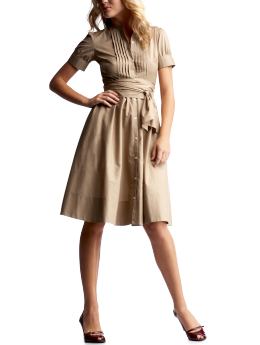
The next one is super simple: knee-length is the easiest length to wear. The dress = 5, everything else = 3.
Here are pictures of looks I DON’T think work:
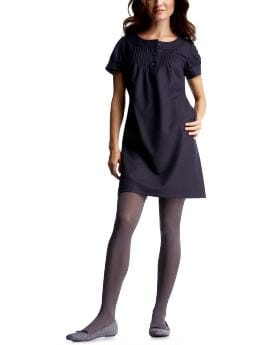
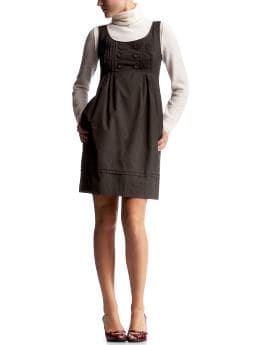
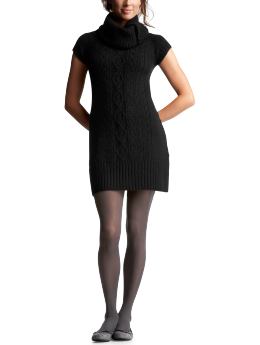
I have said many times, “proportion is key to avoiding frumpiness”. It is challenging to explain. Thankfully, many people seem to get it naturally. To refine your own sense of proportion, join me in trying on lots of outfits. And taking pictures. Then save yourself some work later by keeping notes of what works!. 🙂

I think I get it. You’re right, I find this concept difficult to understand….AND I always think, “as if shopping weren’t complicated enough already…watching for length balancing is beyond me!” But I should learn, I suppose. 🙂
So I have a question. Do you count the ARMS when you’re looking at balance on the top picture, or just legs? In other words, would it still work if she had sleeves? Would the sleeves need to be the same color? And does the gray stripe help it work by giving a distinct visual “three”, even though you get two more heads out of the skirt and shoes? Hmmm….
I don’t know that you need to learn; I try to explain it more as an exercise in understanding it myself. 😉
I have often wondered the same thing about sleeveless versus sleeves, and I don’t know the answer for certain. In theory, I think it’s supposed to be like cuisennaire rods, so a narrow sleeve of the same color would add a little to the dress, but I’m not certain it would make a bunch of difference. The other thing about sleeveless is that it just makes a stronger vertical line, which probably compensates.
The gray stripe starts just where the big part of the dress would start if you broke it down by itself, so it makes it better, but also more complicated.
See what I mean? I’ve been trying to explain it for years and I still struggle! The big thing is to just avoid 50/50. 🙂
I confess, these posts always make my head spin. ;=) I agree with the ones that do and don’t look good, but I don’t get the head length thing at all.
I guess you don’t need to learn how to do it – since you already agree with me. lol
I’m not sure I get the whole explanation, but I can definitely tell instinctively which ones do and don’t work…
I totally agree with you on what doesn’t work! =), I really love that first outfit with those shoes too.
I’ll venture out and say that the 1st and 3rd outfirt don’t work because the shoes are light and so blend in with the skin colour. So it’s dress=4 legs & shoes=4. I always though that nude / light coloured shoes are leg engthening and therefore always flattering, but it seems like that’s not the case if they mess up the proportions.
I agree with you, although it might appear slightly differently if the heads weren’t cut off. Both those outfits would look better now, IMO, with darker ankle boots. And the second one: it is just kinda weird (I haven’t actually given any thought to what makes it weird, though).
A fashion rule I learned (long ago) was that your shoes should not be lighter than your hemline. I’ve observed that this rule is no longer in vogue– but it seems that in your Gap examples here that work, it does apply. Any thoughts??
It seems there are two ways of looking at it: shoes always being darker, based on gravity; and shoes similar to hair, like bookends. For me, having light hair and short legs, it seems, when wearing darker clothes, anyway, that a darker shoe with some element of light, say, in a print or detail, would be ideal. Hard to achieve, but best. 😉
I am still chewing on it, but I think the darker shoes rule, when not combined with the hair color principle, produces a very expected look; so it is appropriate, but not necessarily special. What are your thoughts? (And hair color?) 🙂